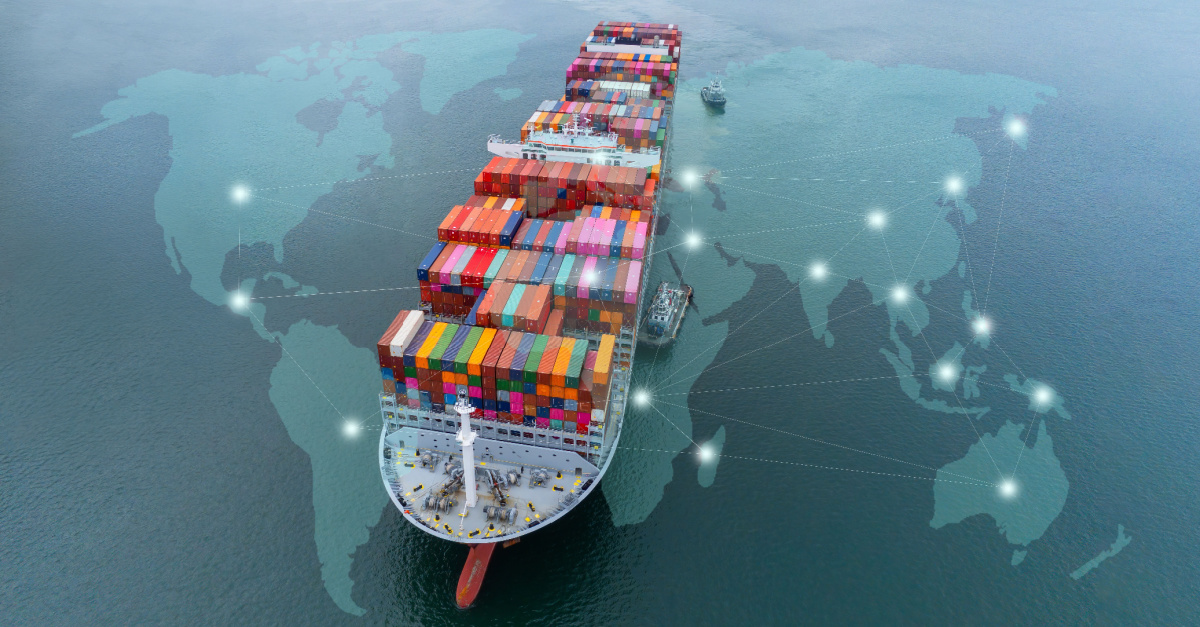Although the international trade landscape is expected to grow by 3.3% in 2024, it is still a complex web of challenges for shippers across the globe, highlighting the need for resilience and innovative practices like collective procurement to get ahead.
The impact of the pandemic and rapidly escalating geopolitical tensions continue to be a disruptive force for supply chains. And shippers are at the frontline of these attacks. This has led to delayed shipments, unpredictable transportation costs, and security challenges for shippers.
Adding to that are the almost constant inflationary pressures, labor shortages, and sustainability concerns that haven’t helped with costs. Trade policies are now more volatile than ever in modern logistics and supply chains. With increasing sanctions, tariffs, and quotas, keeping up with the ever-changing regulations can be a struggle.
There is no doubt that shippers have a lot to overcome. Is it possible, though? There are some solutions—which we will explore in this article.
Collective Procurement As A Transformative Solution
Amid challenges and the complexity plaguing the international trade landscape, collective procurement has emerged as a powerful and transformative solution that can help shippers contend and persevere, even with all the turbulence in the market.
Imagine a coalition of stakeholders, from multinational giants to nimble or smaller shipping businesses, coming together to leverage their collective buying power. By collating shared needs and pooling their resources, these shippers can enter negotiations with suppliers as one entity.
They can secure better deals, optimize pricing, and gain a competitive edge in the market. The cost savings would be astronomical for these businesses, but more than that is the ability to be resilient.
Today’s Shippers Face A Harrowing Logistics Landscape
The logistics landscape is facing more challenges than ever, at least in recent years. Within the last 5 years, you may be hard-pressed to find a time as disruptive as this for the logistics and supply chain industry. It almost seems logistics providers and transporters are being hit from all sides. Here are some of the constant challenges they are facing:
1. Supply Chain Disruptions
Nobody likes a disrupted supply chain. It can send shockwaves worldwide, mainly because of the ripple effects felt in vital chokepoints. Examples of these checkpoints are COVID-19, marine shipping attacks in the Red Sea, and restrictions in the Panama Canal.
Global supply chain disruptions are due to various factors. An example is the ongoing conflict in Ukraine, which has disrupted crucial trade routes and impacted grain and energy shipments globally. If that were all, things may not be so bad. Now, there are rising tensions in the Middle East stemming from the Israel-Hamas war, which has now roped in the Houthi rebels.
In 2024, the Suez Canal Authority implemented new fees. This move further burdened shippers already feeling the impact of rising costs. In the Panama Canal, ongoing expansion projects can potentially lead to temporary closures and disruptions, requiring careful planning and alternative route considerations by shippers.
Unfortunately, getting it all under wraps is still a struggle for shippers, even at a time when freight prices have held low.
2. Cost Fluctuations and Financial Uncertainty
Shippers are constantly being hit with unpredictable cost fluctuations fueled by a confluence of factors that waste no time, negatively impact profit margins, and can cause significant financial challenges.
In the Red Sea, container rates have risen as high as $10,000. The unpredictable nature of these cost fluctuations has put shippers in a situation where it seems like planning is futile. The Red Sea threats led to soaring rates for spot container shipping, whether from the delays caused by port congestion or inefficiencies, global oil prices, or even security concerns.
The Impact On Budgeting And Financial Planning For Shipping Businesses
Cost fluctuations ultimately result in unpredictability, making it difficult for businesses to plan appropriately or predict potential expenses. These prices may differ from trip to trip and, in many cases, could have extreme fluctuations such that these shippers must wait to see on a per-trip basis.
Because of the fluctuations, businesses cannot properly plan because they face the following:
Reduced accuracy: Unpredictable expenses tend to throw business projections, taking them for a loop and complicating financial forecasts.
Difficulty allocating resources: Because of the constant changes, businesses face an uphill battle trying to allocate resources to various operations correctly. It also makes long-term and strategic planning quite challenging.
Cash constraints: Every business needs cash flow to handle operations properly. Delayed or tied-up operations put them in a difficult situation where they may need help to pay suppliers and employees.
3. Navigating Geopolitical Tensions
Nations have been trading for centuries and will continue trading long after today. No one country has all it will ever need. However, the intricate nature of the international trade landscape is such that it needs stability and predictability if it will enjoy any form of success.
Bringing it down to a local level, would you sell to a business in City A that comes with a lot of insecurity and regulations, or would you rather sell to a company in City B where the crime is down and the regulations are far less complicated? This is why nations constantly clamor about geopolitical tensions and take measures (sometimes extreme) to ensure they create the stable and predictable environment required to foster international trade relations.
With geopolitical tensions, every party involved in the trade is impacted, from multinational corporations and small-scale businesses to the communities buying and selling the goods in transit. However, the shippers stand at the forefront of these and have the most to lose when conflicts stir up their heads.
Because of the current geopolitical tensions, shippers and businesses face an increasing likelihood of disrupted trade flows due to blockades or threats on pre-established trade routes.
Sanctions and restrictions limit trade with some countries and regions, making access to certain crucial resources more costly and complicated. A great example of this is the restriction on Russia’s gas, which has forced Europe to source for more expensive alternatives.
When there are geopolitical tensions, you can expect increased security risks in tow, with a spike in insurance premiums right behind them. They come simultaneously and are well-equipped to reduce a shipper’s profit drastically.
Although the impact of geopolitical tensions sounds dreadful, shippers have been able to stay resilient with a wave of strategic thinking and ingenuity. They had no choice if they were going to remain in business. So, how have they been able to pull it off?
- Information sharing and collaboration
- Diversification
- Real-time tracking and monitoring
- Private security details
- Collective negotiations
It is clear that in the current international trade landscape, shippers have to spend more than they ordinarily do to ensure their goods are delivered to the ideal destination on time and under the right conditions. These shippers are paying more, but there are limits to how much they can transfer the cost to the customers.
This is where collective procurement becomes an attractive concept to shippers. In the following section, we will discuss how this concept makes it cheaper and easier for shippers to persevere in the face of mounting challenges.
In A Difficult Moment for the Global Supply Chain, Shippers Stand Together
We have talked in great detail about the woes of shippers, especially under the current international trade landscape. Imagine a scenario where instead of a shipping business battling these woes and challenges by itself, the shipper joins forces with other shipping businesses to tackle these challenges, at least from a procurement or cost-saving perspective.
That is what collective procurement is all about in today’s complex international trade landscape. A group of shippers (large or small corporations) coming together to leverage their combined buying power. By simply acting as one entity, they suddenly have a significant advantage when negotiating with suppliers or vendors.
Collective Procurement As A Strategic Response
Imagine the vast ocean under a violent attack of waves with a small ship right in the middle of it. That is how the challenges of shipping can be for any shipping business. Now, there are several strategies one may use to combat these waves of challenges, but one of the most significant is the collective procurement principle.
As a strategic response to the trading landscape, the concept can help reduce cost, enhance efficiency, improve access, mitigate risks, and facilitate better transparency. So, how will all of these work?
Collective procurement takes advantage of the economics of scale principle. Put simply, the higher the willingness and ability to buy from a single source, the more the price is reduced. Think about this. A supplier manufacturing 100 pieces of propeller takes a month to sell out. If the supplier sells each at $10,000, it will take a month to make $1,000,000 in sales. What if the supplier met a buyer willing to buy 80 out of the 100 propellers? How much discount do you think the buyer will get?
The Power Of Unity In Facing Complex Logistics Challenges
Now, one shipping business may be unable to pull it off because the shipper will need to allocate financial resources to other areas of the business. But what if ten, twenty, or even a hundred come together to improve their purchasing power? They would get massive discounts, translating to cheaper parts and services, ultimately giving these shippers a fighting chance against the unfriendly international trading landscape.
But it is more than just cost reduction. These shippers can create an ecosystem to share resources and information and mitigate risks. It also gives them some power against government rules and regulations.
Mitigating Supply Chain Disruptions Through Collaboration
Although suppliers are one of the essential factors in any successful supply chain, they can sometimes be the cause of a failed supply chain. This will typically happen because they fail to meet expectations, resulting in downtimes and disruptions for the entire supply chain. No doubt, having good options comes in handy.
Strong buying power means businesses will attract some of the best suppliers in any affiliated industry. It is an interesting phenomenon. The best are usually the biggest, and the biggest are usually the best.
What this means for shippers pulling their resources together is that they have access to the best suppliers, and when one supplier fails, they do not have to rely on an unreliable backup option. These shippers can immediately pull resources and begin negotiations with another supplier who can do business with them.
This is a great way to eliminate disruptions and potential downtimes in the supply chain.
Sharing Resources and Insights For Enhanced Resilience
Battling supply chain disruptions is about more than tackling the supplier challenge. Collective procurement also allows shippers to tackle the information challenge. Shippers take different routes to different regions at different times. And they encounter different situations and developments during transportation.
Shippers are seldom surprised by any development or situation that may arise by sharing resources and insights. This is because they have prior insights from the existing pool, which helps them take necessary precautions. Ultimately, it keeps the supply chain resilient because it is prepared for the crisis and challenges.
Financial Stability Through Collective Negotiation
The group has way more power than the individual, and for many shippers, that power could spell the difference between success and oblivion. Cost fluctuations can make a mess of any business’s financials. It restricts the shipper’s ability to plan and allocate resources effectively and predict profitability. However, with collective procurement, these will go differently.
Shippers can now use the power of the collective to negotiate favorable terms, which include longer, cheaper, and more stable contracts. Think about it. Like the example we gave earlier about propellers. The more an entity can and is willing to buy from any one source, the more power that entity has to enjoy better deals and various options.
Suddenly, this shared entity has more options and power to demand better services, rates, and deals.
Gemini Shippers: The Key to Shipper Solidarity
Working together with other shippers can be a cumbersome ride in a shipping business. You may be plagued with questions like how do you go about it, who do you meet, and how do you start the negotiations? Solving for all these can be draining, but the good news is that you never have to.
Enter Geminini Shippers, a vibrant community that enjoys all the benefits of collaborative procurement. The association, headquartered in New York, has a 100-year history of helping shipping companies reach their goals and stay relevant despite several economic and international trade challenges.
Beyond just bringing shippers together, it is one of the driving forces ensuring the push for tech in the logistics industry. At Gemini Shippers, we have a diverse base and take the following steps to ensure every shipper benefits from the system. With collective procurement, you can pool resources with other shippers like yourself and increase your buying potential. This way, you can get better deals and enjoy longer and more stable contracts, all while sharing resources and insights.
Again, this is all possible at Gemini Shippers. Become a member today. Check out our benefits here.



